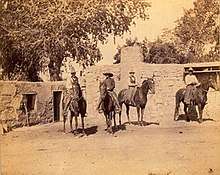Apache Tejo
Apache Tejo (sometimes 'Tejoe' or 'Teju') was a white settlement and watering stop in the New Mexico Territory, 12 miles southeast of Silver City, 3 miles south of Hurley, and 2 miles east of the Grant County Airport. It is just off U.S. Route 180, about 12 miles west of the mail route crossing of the Mimbres River[1] and on the old Santa Rita-Janos (Chihuahua) trail.[2] There was a railroad siding here once.

The etymology of the name is unclear. It may have been derived from the name of a Chihenne leader of the 1770s, Pachiteju,[3] but other accounts called it Apache de Ho(o), which might mean 'Apache water'.[2]
The U.S. Army's Fort McLane was established here in 1860, on the bank of a small spring. The commander reported that it had sufficient "water, timber, and grazing" to support the fort.[1] It was originally named Fort Floyd, after Secretary of War John B. Floyd. After Floyd joined the Confederacy, it was renamed to honor a Captain George McLane, who had been killed by Navajos. It was finally abandoned in 1864.[2]
In the context of the Apache Wars, the Apache chief Mangas Coloradas held a council here with the white settlers in about 1863, where the Apache were promised provisions in return for peace, according to Geronimo. Mangas Coloradas and his people duly arrived and were "foully murdered after he surrendered".[4]
In 1877, Billy the Kid joined a group of "thieves and rustlers" known as the Boys here.[5]
—Owen Wister, author of The Virginian[6]
Owen Wister, "father of western fiction", visited the Apache Tejo ranch in 1895. He described it as "a little oasis of hay field, cottonwoods, a spring, and some flowers and grass in front of the adobe house".[7] The foreman of the ranch, Dean Duke, was one of the inspirations for the protagonist of Wister's The Virginian.[6]
The Apache Tejo Hot Springs, with water issuing at 94 °F, were used as a water source by the Chino Copper company for the Chino mine; the company built a pumping station and a wooden pipeline to Hurley.[8] The spring no longer flows.[9][5] As of 1916, this water was also used as the domestic water supply of Hurley.[10] The large tailings pond of the mine lies 1 mile to the southeast.
Notes
- Sweeney, p. 396
- Robert Hixson Julyan, The Place Names of New Mexico, 1996 ISBN 0826316891, p. 135
- Edwin Russell Sweeney, Mangas Coloradas, Chief of the Chiricahua Apaches, p. 526n10
- Geronimo, S.M. Barrett Geronimo: The True Story of America's Most Ferocious Warrior, 1906, republished 2011 ISBN 1616087536, p. 73-74
- Michael Wallis, Billy the Kid: The Endless Ride, 2008 ISBN 0393075435
- Paul Green, A History of Television's The Virginian, 1962–1971, 2009 ISBN 0786457996, p. 13
- Gary Scharnhorst, Owen Wister and the West 2015 ISBN 0806149868, p. 88f
- Hercules Powder Company, The Explosive Engineer: Forerunner of Progress in Mining, Quarrying, Construction 18:55, 1940?
- James C. Witcher, "Faywood Hot Springs", GHC Bulletin, December 2002, p. 46
- Donald Francis MacDonald, Charles Enzian, Geological Survey (U.S.), Prospecting and mining of copper ore at Santa Rita, New Mexico, Govt. print. off., 1916